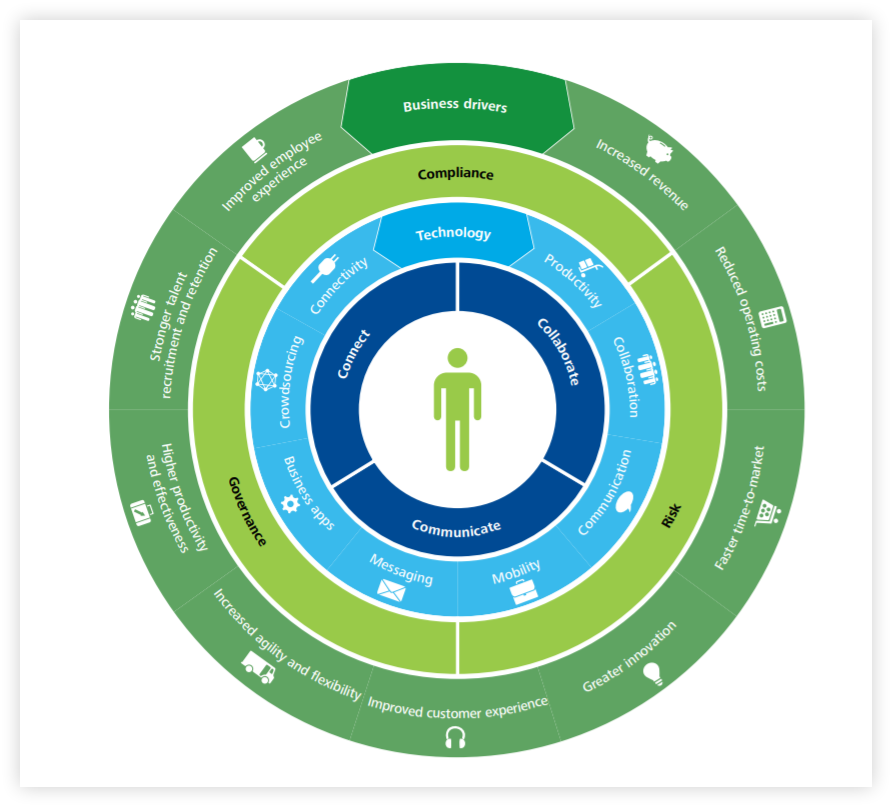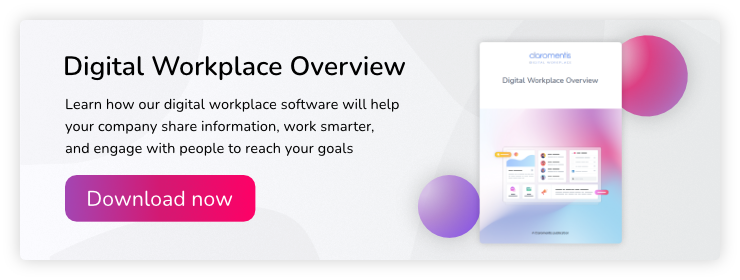The digital workplace is the engine of the digital economy. It is where innovation happens, ideas are nurtured, and collaboration takes place. However, the digital workplace is about more than just new technologies – it’s a culture shift that requires an entirely new way of thinking about work.
In this article, we’ll discuss five steps for developing a digital workplace strategy that will transform your company into one of the most innovative enterprises in today’s digital world.
What is a digital workplace strategy?
But, before we get into the steps to developing a digital workplace strategy, let’s deconstruct the concept of a digital workplace.
The digital workplace, in essence, is the natural progression of the workplace as we know it. It’s made up of your workers’ technology-driven work environment. Thus, the digital workplace comprises all of today’s workforce technologies – both those currently in use and those yet to be introduced.
It includes everything from your intranet to HR programs and business applications, as well as email, instant messaging, corporate social media tools, virtual meeting tools, and any other digital workplace platform.
Because most organisations already utilise many of these elements, you don’t have to start from scratch with your digital workplace. You may be closer to operating a digital workplace than you think if your employees respond to emails from their phones, check their payslips online, or digitally enter a sales opportunity into a system.
Even if new tools are required in some instances, the benefits greatly outweigh the costs. Organisations that do not embrace the digital workplace may fall behind as the workplace evolves and employee expectations change.

(Image source: deloitte.com)
Benefits of a digital workplace strategy
The risk of inaction should be a sufficient motivator – but in case you aren’t convinced, consider the following benefits according to The Digital Workplace report by Deloitte:
- Talent attraction: Almost two-thirds of workers would choose a lower-paying job if they could work remotely
- Employee productivity: Organisations with strong internal online social networks are 7% more productive than those without
- Employee satisfaction: Organisations that implement social network tools internally report a 20% boost in employee satisfaction
- Employee retention: When employee engagement improves, so does employee retention – by up to 87%
- Communication tools: Employees are more likely to use newer communication technologies, particularly instant messaging, than more conventional alternatives like email
Digital workplace components
There are digital workplace components that you should include in your digital workplace strategy.
- Digital Workplace Platforms: These include the digital platforms and technologies used by employees to work remotely and collaborate on projects with their colleagues, such as smartphones, tablets, instant messaging programs, video conferencing services, digital project management tools, and digital meeting solutions.
- Digital Workplace Management Tools: These are the systems used to manage employees’ digital workplace use – such as directory services that provide single sign-on (SSO), identity governance and provisioning capabilities, data security software that allows for multi-factor authentication (MFA) and digital identity protection, and security tools to protect web applications.
- Digital Workplace Analytics: These are used by digital workplace managers to understand how employees engage with digital workplaces, such as workforce analytics software which provides real-time insights into all aspects of workforce health including engagement, digital workplace uptake, and usage.
- eLearning solutions: Digital workplace learning tools are used to grow and develop employees’ professional skills, whether for on-the-job training or career development courses.
- Intranet: Intranets allow businesses to securely share information across the organisation with a common portal that includes news and announcements, calendars, collaboration spaces (for projects and teams), document repositories and digital workspaces, digital workplace tools (for employees only), digital employee directories and business applications.
How do you create a digital workplace?
Now that you’ve got a better idea of what digital workplace components are available to help your organisation develop its digital workplace strategy, let’s look at the top five steps required for developing one.
Step 1 – Assess your current digital workplace
Gather digital workplace data that will help you identify the current state of your digital workplace. For example, is it secure? Is there a digital employee directory to ensure employees can easily find each other when they are working remotely or out on business travel? What type of software tools do employees use for collaboration and project management?
Step 2 – Define your digital workplace vision
What is your vision for your digital workplace? If you don’t have a clear vision, you may find yourself investing in new technologies and platforms that don’t bring you long-term business benefits. Your digital workplace vision must be in sync with your company’s objectives to produce good outcomes.
Step 3 – Map your digital workplace strategy
Create an action plan that maps out the steps required to implement your digital workplace strategy. This includes who will carry out each task, what will be accomplished, when each task must be completed, and how digital workplace elements will integrate into your existing technology infrastructure.
Identify digital workplace elements that are most important to your employees and your organisation. Once you’ve identified what’s critical for success in your digital workplace strategy, prioritise how these digital workplace components will be used and by whom.
Step 4 – Build your toolbox
A digital workplace toolbox contains all the tools and technologies that staff require to complete their tasks. Keep in mind, though, that you can only establish a successful toolbox if you first established your vision of the ideal digital workplace. Otherwise, new technology may benefit specific departments or groups – or even no one at all.
Step 5 – Implement your digital workplace strategy
The final step in digital workplace strategy development is implementing the digital components of your plan. You do this by deploying tools that enable digital workplaces to be used for collaboration and project management, communication, learning and development, and customer engagement.
Digital workplace platform
Once you have a strategy in place, we recommend you acquire a digital workplace platform. It comprises an integrated suite of digital technologies that can be deployed together or as individual components to create a virtual office environment.
Don’t be left behind as your competitors transform. The time is now to turn your digital workplace vision into reality.






